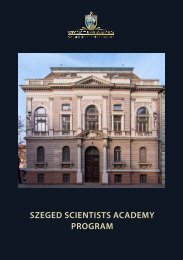SzSA YearBook 2016/17
Create successful ePaper yourself
Turn your PDF publications into a flip-book with our unique Google optimized e-Paper software.
SZENT-GYÖRGYI JUNIOR MENTORS<br />
SZILVIA VESZELKA<br />
Institute of Biophysics<br />
Biological Research Center of the<br />
Hungarian Academy of Sciences<br />
Address: 6726 Temesvári krt. 62., H-6725 Szeged, Hungary<br />
E: veszelka.szilvia@brc.mta.hu<br />
T: +36 62/599-600<br />
RESEARCH AREA<br />
Pharmaceutical treatment of most disorders of the central<br />
nervous system, including neurodegenerative diseases<br />
and brain tumors, is restricted due to the poor penetration<br />
of drugs across the blood-brain barrier, the major entry<br />
route for therapeutic compounds to the central nervous<br />
system. The great majority of neuropharmaceutical candidates,<br />
hydrophilic molecules, biopharmaceuticals, and<br />
efflux transporter ligands have a low permeability across<br />
the blood-brain barrier. Biocompatible and biodegradable<br />
drug targeting systems, so-called nanocarriers hold a great<br />
promise. Nanovesicles which can encorporate drug cargos<br />
and present on their surfaces ligands for blood-brain barrier<br />
endogenous nutrient transporters achieve increased specificity<br />
and efficacy for drug delivery across the blood-brain<br />
barrier. Combination of such ligands is a novel and innovative<br />
idea which could contribute to develop systems for<br />
better treatment of central nervous system diseases.<br />
TECHNIQUES AVAILABLE IN THE LAB<br />
In vitro cell culture works, isolation of brain endothelial cells<br />
(rat/mouse), toxicity measurements (MTT/LDH tests, double<br />
cell nuclei staining, real-time cell monitoring assay), resistance<br />
measurement, cell uptake and blood-brain barrier<br />
transport experiments, immunohistochemistry, confocal<br />
microscopy, scanning electron microscopy, spectrofluorometer<br />
measurements. Preparation of nanoparticles, zeta<br />
potential and size measurements.<br />
SELECTED PUBLICATIONS<br />
Sántha, P., Veszelka, S., Hoyk, Z., Mészáros, M., Walter, FR.,<br />
Tóth, AE., Kiss, L., Kincses, A., Oláh, Z., Seprényi, G., Rákhely,<br />
G., Dér, A., Pákáski, M., Kálmán, J., Kittel, Á., Deli, MA. (<strong>2016</strong>)<br />
Restraint stress-induced morphological changes at the<br />
blood-brain barrier in adult rats. Front Mol Neurosci 8:<br />
Paper 88. 15 p.<br />
Walter, FR., Veszelka, S., Pásztói, M., Péterfi, ZA., Tóth, A.,<br />
Rákhely, G., Cervenak, L., Ábrahám, CS., Deli, MA. (2015)<br />
Tesmilifene modifies brain endothelial functions and opens<br />
the blood-brain/blood-glioma barrier. J Neurochem 134:<br />
1040-1054.<br />
Veszelka, S., Tóth, A.E., Walter, F.R., Datki, Z., Mózes, E., Fülöp,<br />
L, Bozsó, Z., Hellinger, É., Vastag, M., Orsolits, B., Környei, Z.,<br />
Penke, B., Deli, M.A. (2013) Docosahexaenoic acid reduces<br />
amyloid β-induced toxicity in cells of the neurovascular<br />
unit. J Alzheimers Dis 36: 487-501.<br />
Veszelka, S., Kittel, Á., Deli, M.A. (2011) Tools of Modelling<br />
Blood-Brain Barrier Penetrability: Chapter 9. In: Tihanyi K ,<br />
Vastag M (editors), Solubility, Delivery and ADME Problems<br />
of Drugs and Drug-Candidates. 232 p., Washington:<br />
Bentham Science Publishers Ltd., 2011. pp. 166-188.<br />
Veszelka, S., Pásztói, M., Farkas, AE., Krizbai, I., Ngo,<br />
TK., Niwa, M., Abrahám, C., Deli, MA. (2007) Pentosan<br />
polysulfate protects brain endothelial cells against bacterial<br />
lipopolysaccharide-induced damages. Neurochem Int 50:<br />
219-228.<br />
93












